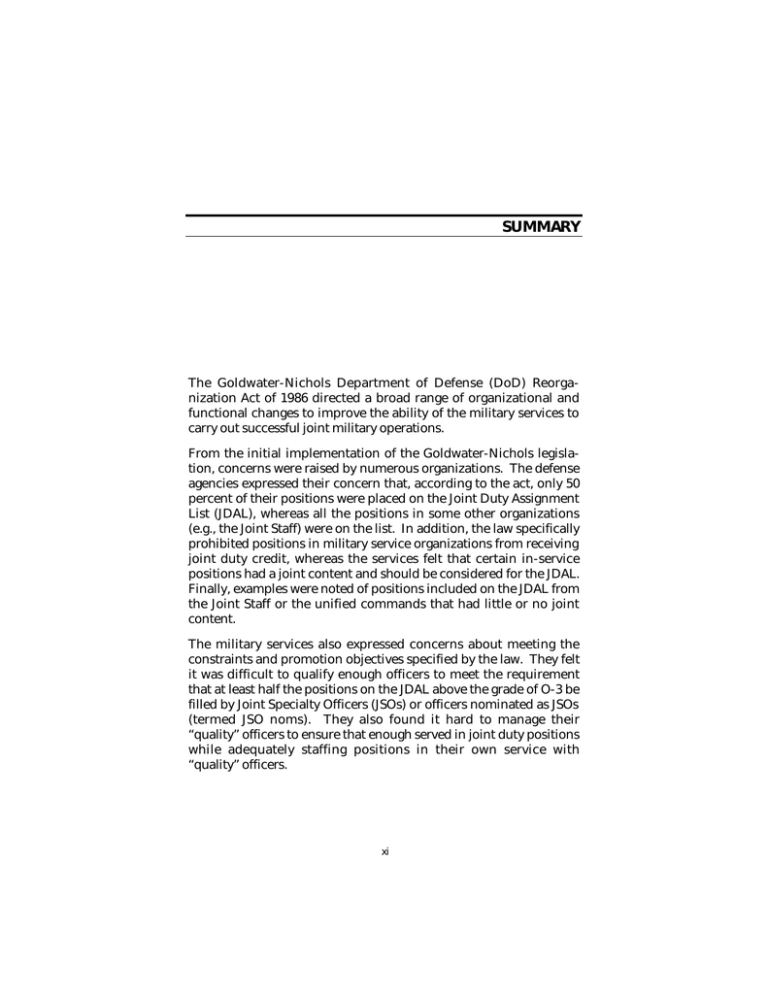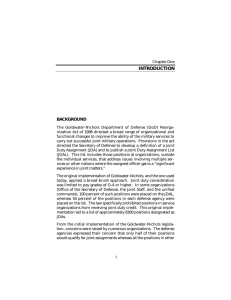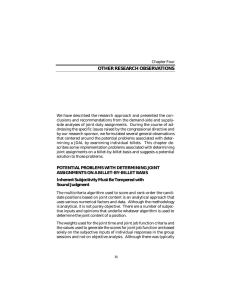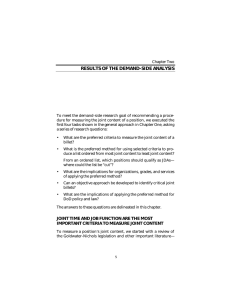SUMMARY
advertisement

SUMMARY The Goldwater-Nichols Department of Defense (DoD) Reorganization Act of 1986 directed a broad range of organizational and functional changes to improve the ability of the military services to carry out successful joint military operations. From the initial implementation of the Goldwater-Nichols legislation, concerns were raised by numerous organizations. The defense agencies expressed their concern that, according to the act, only 50 percent of their positions were placed on the Joint Duty Assignment List (JDAL), whereas all the positions in some other organizations (e.g., the Joint Staff) were on the list. In addition, the law specifically prohibited positions in military service organizations from receiving joint duty credit, whereas the services felt that certain in-service positions had a joint content and should be considered for the JDAL. Finally, examples were noted of positions included on the JDAL from the Joint Staff or the unified commands that had little or no joint content. The military services also expressed concerns about meeting the constraints and promotion objectives specified by the law. They felt it was difficult to qualify enough officers to meet the requirement that at least half the positions on the JDAL above the grade of O-3 be filled by Joint Specialty Officers (JSOs) or officers nominated as JSOs (termed JSO noms). They also found it hard to manage their “quality” officers to ensure that enough served in joint duty positions while adequately staffing positions in their own service with “quality” officers. xi xii Identifying and Supporting Joint Duty Assignments: Executive Summary Congress recognized these concerns and tasked DoD to revisit the implementation of the Goldwater-Nichols legislation. RAND’s research approached these concerns from both the demand and supply sides. The goal of the demand-side research was to recommend a procedure for measuring the joint content of a position; the goal of the supply-side research was to determine how many of the positions with joint content the services could support. RESULTS OF DEMAND-SIDE ANALYSIS From the demand-side analysis, we conclude that a billet’s joint content can be adequately and sufficiently measured using a combination of joint time (JT) and joint job function (JF). Regardless of where a list ordered on joint content is “cut” to form a new JDAL, the following statements can be made: (1) virtually all the billets identified as JDAL candidates by the Joint Staff have some joint content associated with them; (2) based purely on the joint content algorithm, no organization will have all its positions on a new JDAL, and the defense agencies will not uniformly have 50 percent of their positions on a new JDAL; (3) some O-3 and in-service positions have significant joint content (including these positions on a new JDAL would require changing the law and current DoD policy); and (4) using a systematic approach to determining which positions are “critical joint billets” is preferred to the subjective approach currently used by organizations. Such an approach reveals that there are likely to be fewer critical billets than the 1000 figure stated in the Goldwater-Nichols legislation. Based on these results, we recommend that (1) billets be rankordered based upon their joint content as determined by using the JT/JF algorithm; (2) the size of a new JDAL (i.e., where to “cut” the ordered list) be based on the number of joint positions the services can support; (3) a specific methodology be employed for identifying critical billets; (4) DoD policy be changed to allow O-3s to receive joint credit; and (5) changes be requested to Goldwater-Nichols to allow in-service billets for grades of O-4 to O-6. Summary xiii RESULTS OF SUPPLY-SIDE ANALYSIS From the supply-side analysis, we observe several factors that affect supportability—promotion policy objectives, current law, Joint Professional Military Education (JPME) output, and military service assignment policy. Promotion policy objectives hinder supportability because they are flawed (and thus produce a personnel management problem); as a result, they must be made simpler and more valid. Given current law, JPME output, and service assignment policy, the maximum JDAL supportable is approximately 9900 positions above the rank of O-3. Based on these results, we recommend that (1) the services request legal changes that would result in more appropriate promotion comparisons and require comparison reports only for promotions to grades of O-5 and O-6, which would provide a valid indicator of whether the services are meeting the objectives of GoldwaterNichols; (2) both the annual promotion board data and a moving average be included in the promotion reports; and (3) that the belowzone, within-zone, and above-zone comparisons be combined to simplify the promotion comparison calculations. The latter could be done without changing the current law. OTHER RESEARCH OBSERVATIONS During our interviews, we often heard about the morale problems that can exist in “split organizations” where some, but not all, of the positions are on the JDAL. Using the JT/JF algorithm to determine JDAs on a billet-by-billet basis could make the problem worse by creating more split organizations. Our analysis shows, however, that almost all billets have some joint content, so that granting joint credit to all officers at joint organizations would greatly simplify implementation procedures while increasing overall morale. The real question is, can the services support such a large list? As we’ve noted, the services could support a JDAL of about 9900. However, the maximum supportable size could be increased even more (to about 10,600), according to our analysis, if the Armed Forces Staff College throughput were not constrained. In addition, by changing the law and DoD policy in various ways, the size of the list can be further increased to as high as 15,000.






